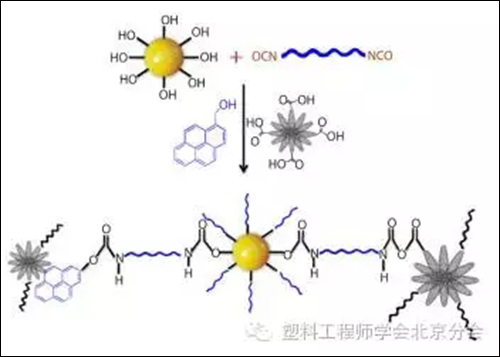一種多功能的合成方法,可用于實現(xiàn)高性能富氮超支化聚合物-碳納米角復合材料的制備。
近年來,碳在各種工業(yè)應用中(例如電子產(chǎn)品、紡織品和涂料),已經(jīng)成為一種很有前景的材料。事實上,碳在結(jié)構方面的分子水平的變化,使得其產(chǎn)生了許多寶貴的同素異形體(每種都具有獨特的物理化學性質(zhì)和熱機械性能)。尤其是碳納米管、碳納米顆粒以及石墨烯,由于其作為涂料配方的一種良好材料而備受關注。然而,碳粒子在這些涂料中的分散性差,這是一個主要的約束(即不恰當?shù)姆稚е虏牧现械男阅芊植疾痪鶆颍?/span>
在之前的工作中,我們已經(jīng)證明,通過碳材料的共價或非共價功能化(其中碳是基本功能部分的裝飾)能夠解決這個分散問題。在非共價官能化中π-π堆疊是用來添加芳族烴,而功能部分是共價鍵方法的關注點所在。此外,最近在涂層技術方面有一個很大的進步,使得在單層涂料中變成多功能。這種多功能涂層(例如,包括聚氨酯)是特別有趣,因為聚合物和一系列碳填料之間的相容性。為了改善這種碳填料在聚合物基體內(nèi)的分散性,支化聚合物系統(tǒng)已被認為是一種。例如,在過去的幾十年里,不同支化聚合物體系和用于確定支化程度的表征工具以及計算分子參數(shù)的聚合物動力學都得到了發(fā)展。此外,這種含有雜原子(如氧、氮、硼、氯)的球狀結(jié)構的分支聚合物體系,使得高聚物化學易于操作。含氮前驅(qū)體材料是易于獲得的,并且具有一些有趣的性質(zhì)(例如,微生物性、腐蝕抑制作用以及良好的附著力)。
因此,在我們最近的工作,我們研究了富氮超支化聚氨酯-碳納米復合材料系統(tǒng)。我們也使用這種復合材料開發(fā)出了一種高性能的多方面的化學涂層。特別是,我們將單壁碳納米角作為超支化聚氨酯基體中的填充材料,其中這種超支化聚氨酯的支化度達到將近60%。
為了合成我們的超支化聚氨酯基體,我們采用癸二酸作為前體物質(zhì),它是蓖麻油的衍生物(即一種自然產(chǎn)生的物質(zhì))。我們還采用一種標準的縮聚反應——三個羧基基團和四個羥基基團以及葵二酸發(fā)生反應——形成了一個由富氮超支化聚醚多元醇封端的羥基。然后我們的的超支化聚合物與異氰酸酯發(fā)生反應,從而形成聚氨酯脲涂層。為了實現(xiàn)碳納米角在聚氨酯基體中的良好分散,我們在納米角上進行了熒光芘基團的π-π堆疊。此外,我們還在納米角表面增加了羧基官能團,從而使得聚氨酯中的(–NCO)基團形成共價鍵。

圖1 碳納米角-聚氨酯復合材料(CNH-PU)的形成示意圖。C:碳。O:氧。H:氫。N:氮。
在我們的研究中,我們也遵循一個獨特的策略來將納米填料添加至聚合物基體中。具體而言,在多羥基化合物與–NCO基團反應時(即形成異氰酸酯聯(lián)動),我們向體系中添加了碳納米角和1-芘甲醇(如圖1所示)。羧基與–NCO之間形成酰胺鍵,并且實現(xiàn)非共價功能化。此外,在1-芘甲醇中的羥基形成異氰酸酯,從而提高體系內(nèi)的交聯(lián)。因此,我們的復合材料是高度相互關聯(lián)的體系,包括共價和非共價功能化。

圖2 (a)裸露的低碳鋼鋼板(b) 0% CNH(即純 PU),(c)0.1% CNH以及 (d) 0.5% CNH的CNH-PU混合涂層的極化測量。在一個3.5%氯化鈉溶液中,使用塔菲爾法進行測量。
我們的復合材料的交聯(lián)氨基甲酸酯段可以被用來在低碳鋼(即少量的碳)的表面形成一個阻擋層,從而限制腐蝕性物質(zhì)的滲透。此外,我們使用的熒光基團為早期的腐蝕檢測提供了范圍。因此我們進行了一系列實驗,從中我們發(fā)現(xiàn),與那些純聚合物相比,在聚氨酯基體中加入非常小的量的碳納米角(0.1–0.5%)可以使理化性能與熱性能得到巨大的改善(如圖2所示)。例如,我們的復合材料具有較高的儲能模量(約1081MPa)和較低的腐蝕率(6.16×10-5毫米/年)以及良好的靈活性。
總之,我們開發(fā)了一種通用方法,用于實現(xiàn)制備氮核超支化聚合物–碳納米角復合材料(支化度約為60%)。我們還表明我們的復合材料的特殊存儲模量、耐腐蝕性、靈活性和熒光我們的材料性,可作為我們的合成方法成功的證據(jù)。像這種涂層在未來可能會發(fā)展其他的應用,比如作為熒光探針、分子印跡傳感器或作為潮濕環(huán)境中腐蝕保護的涂層。在未來的研究中,這將是控制我們聚合物的支化度、化學結(jié)構、分子量和多分散性指數(shù)所必要的。此外,我們想找一種將雜原子摻雜到聚合物中的更容易的方法(即減少處理步驟)。最后,我們打算將線性和超支化體系結(jié)合,從而使我們的合成方法能夠進一步突破。
作者信息
Srinivasarao Pilla
Polymers and Functional Materials Division, Indian Institute of Chemical Technology (CSIR)
Srinivasarao Pilla received his master's in chemistry from Andhra University, India, in 2010. He then joined the Polymers and Functional Materials Division at CSIR for his PhD, which he received in 2012 from the Academy of Scientific and Innovative Research (India)。 He subsequently received a junior research fellowship in 2012 and a senior research fellowship in 2014. His current research interests are focused on the fabrication of hyperbranched molecular architectures and nanocomposites, and using biobased materials for the development of high-performance coatings/nanocomposites.
Rohit Ranganathan Gaddam
Polymers and Functional Materials Division, Indian Institute of Chemical Technology (CSIR)
Rohit Ranganathan Gaddam is currently a PhD student at the University of Queensland (Australia), under the supervision of Xiu Zhao and Ashok Nanjundan. He has been awarded International Postgraduate Research and University of Queensland Centennial scholarships for his PhD study. He previously worked at CSIR as a researcher and has conducted work at the Central Glass and Ceramic Research Institute and Central Electrochemical Research Institute (both part of CSIR)。 He holds an MTech in nanotechnology. His research interests are focused on bioderived carbon materials for energy-storage devices.
Ramanuj Narayan
Polymers and Functional Materials Division, Indian Institute of Chemical Technology (CSIR)
Ramanuj Narayan has been a senior scientist at CSIR since 2008. He received his bachelor's degree (1991) from Magadh University, India. He then completed a master's in chemistry (1994) at the University of Delhi, India, and in technology (1996) at the National Institute of Technology, India (with a focus in surface and colloid science)。 He subsequently conducted research on the development of high-solid and water-dispersable coatings at CSIR (under the supervision of Kothapalli Raju) and was awarded a PhD in 2002 from the Indian School of Mines. He has since worked as a research scientist at Aisin Cosmos R&D Co. Ltd, a researcher at R&D Tata Steel Ltd, and a senior scientist in the Composites Division of Tata AutoComp Systems Ltd. His research interests include organic, polymeric, and hybrid materials for functional coatings, composites, and third-generation solar cells.
Kothapalli V. S. N. Raju
Polymers and Functional Materials Division, Indian Institute of Chemical Technology (CSIR)
Kothapalli V. S. N. Raju recived his master's and PhD from Osmania University, India. He then worked in Werner Funke's laboratory in Germany. His current research interests are focused on organic–inorganic hybrids, as well as the functionalization of nanomaterials, hyperbranched polymers, thermoset polymers, and triazole chemistry for the development of functional polymers.
更多關于材料方面、材料腐蝕控制、材料科普等等方面的國內(nèi)外最新動態(tài),我們網(wǎng)站會不斷更新。希望大家一直關注中國腐蝕與防護網(wǎng)http://www.ecorr.org
責任編輯:王元
《中國腐蝕與防護網(wǎng)電子期刊》征訂啟事
投稿聯(lián)系:編輯部
電話:010-62313558-806
郵箱:ecorr_org@163.com
中國腐蝕與防護網(wǎng)官方 QQ群:140808414
免責聲明:本網(wǎng)站所轉(zhuǎn)載的文字、圖片與視頻資料版權歸原創(chuàng)作者所有,如果涉及侵權,請第一時間聯(lián)系本網(wǎng)刪除。
-
標簽: SPE-China, 耐腐蝕涂層, 納米碳/聚氨酯復合材料, 制備

官方微信
《中國腐蝕與防護網(wǎng)電子期刊》征訂啟事
- 投稿聯(lián)系:編輯部
- 電話:010-62316606-806
- 郵箱:fsfhzy666@163.com
- 中國腐蝕與防護網(wǎng)官方QQ群:140808414





